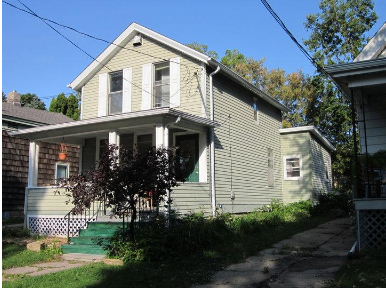






The word “landlord” does not always conjure up the image of someone who wants to put extra effort into making a rental unit environmentally-friendly. More common is the image of someone who wants to maximize short-term economic gain, often by cutting corners that an owner-occupant would not.
On the other hand, renters who want to live in an environmentally-friendly manner generally control only a few of a unit’s features that can make it more energy-efficient. Their choice of apartment location does give them control over the environmental impacts they make from transportation, such as renting close to work to make walking or bicycling convenient. Inside the apartment, tenants don’t have as much influence. They can turn the thermostat down low in the winter, turn it up for less air conditioning in the summer, or turn the lights off more often, for example, but they will still not be able to influence larger energy uses much.
 Green apartments in Madison are more than about utility use. Proximity to public transportation access also makes an apartment green. (Susan De Vos)
Green apartments in Madison are more than about utility use. Proximity to public transportation access also makes an apartment green. (Susan De Vos)
Madison is an uncommon place, however. It is the home of Green Apartment Network, a community comprised of landlords (property owners), tenants (renters), contractors and service providers who work together toward making living spaces safe, healthy, comfortable, sustainable, efficient, clean and in as much harmony with land and nature as possible. The network is a not-for-profit Wisconsin cooperative, has a set of by-laws, and functions so that each member has one vote no matter what size. Membership is open to anyone willing to hold to a set of principles that includes “no greenwashing,” transparency, honesty, fairness, professionalism and education.
Network members share information and best practices. Intentions include encouraging, developing, and celebrating ecologically and economically beneficial measures, technologies, behaviors, and business strategies.
The Network has also developed a “greener apartment identifier,” a checklist of seven factors to consider when calling a specific property environmentally-friendly:
The factors are in question form, with fact-based sub-questions to make it clear and easy to fill out.
This list is a collection of topics dealt with by most general assessments of environmentally-friendly living arrangements. More details and ideas are available in the guide Steps to Greener Living from the Madison Environmental Group’s EnAct program. While this guide suggests actions mainly applicable to owner-occupants, the Green Apartment Identifier focuses on rental properties and is designed to be completed by property owners or property managers.
For transportation, Greener Apartment Identifier questions are:
One of the facts about Madison today (2016) is that less than two thirds of its households have access to a transit stop of any kind, even to one only used for weekday peak hour service (roughly 6:30-9:30 a.m. and 2:30-5:30 p.m.). Weekend service is particularly limited. Land use planning and development lacking a major focus on public transportation has been the norm here for the last half century, and public transit has suffered as a result. So even when available, many bus stops can be far from “convenient,” and the question is far from idle.
The dilemma is that buildings with convenient access to a bus stop serving a main transit route tend also to be older, built when there were lower standards for the efficient use of resources, and often left to deteriorate from what may have been a lower standard to begin with. Disinvestment in our inner cities has been rampant all across our country, and Madison is no exception. Although we are beginning to emerge from that trend, it is not hard to still see signs of continued disinvestment all around.
The Green Apartment Network encourages investment in older structures in a business-friendly way. Sometimes, that may result in somewhat higher rent in the short term despite an overall adherence to the three Rs in the long term: Reduce, Reuse and Recycle. Fortunately, a survey in 2013 found that more than half of those apartment renters would be willing to pay a little more for an environmentally-friendly unit. Although the survey stressed such factors as energy efficiency and water usage, it can also be true that the possibility of higher rent may be compensated for by the savings that comes from using travel modes such as the bus and ride share in lieu of owning and operating one’s own automobile.
|
|
|
Welcome to the Madison Commons, a website designed to provide news and information about all of Madison's neighborhoods and a crossroads for the discussion of community issues. The name comes from the idea of a village commons, a place for news, talk, debate, and some entertainment, too, that's open to everyone.
All rights reserved. Read more about the Madison Commons and its partners.

